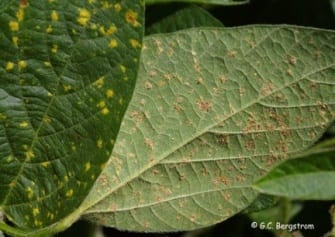by Jaime Cummings, NYS Integrated Pest Management Field Crops and Livestock Program Coordinator

The weather has changed from hot and dry to warm and wet in many parts of the state, and that has changed our expectations for soybean diseases this year. Many of us are seeing downy mildew in soybeans across the state, ranging from low to high incidence and severity, and some are wondering what, if any, management options are recommended. As a general rule, we have never recommended spraying fungicides for downy mildew because this disease is typically more of a cosmetic issue which doesn’t tend to result in noticeable yield loss. Though, there have been reports from other states indicating 10-15% yield losses from very severe downy mildew epidemics. We have no established thresholds for when to pull the trigger for downy mildew fungicide management in New York State, and have no fungicide efficacy data to provide strong recommendations. And, keep in mind, most of our foliar fungicides available for soybeans are not labeled for downy mildew and would have very limited effect, if any, because downy mildew is an oomycete and is not in the same category as most of the rest of our foliar fungal diseases that are well controlled with many fungicides. There is limited research-based evidence that strobilurin fungicides may have limited efficacy against downy mildew, but, again, many aren’t actually labeled for downy mildew in NY. However, Aproach Prima is labeled for downy mildew in soybeans in NY, and can be applied at a 5 – 6.8 fl oz/A rate, (http://www.cdms.net/ldat/ldBA3003.pdf). Given the general lack of efficacy data from NY or other states, it is unclear whether or not these applications will be cost effective, and should be reserved only for the most severely affected fields.

